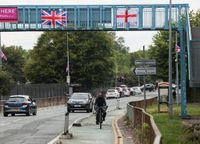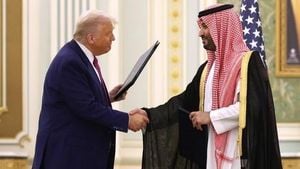In recent weeks, the streets of England have become a canvas for a new and contentious display of national identity. Red and white St George’s Crosses and Union Jack flags have appeared in neighborhoods from the West Midlands to the Isle of Dogs in London, sparking a heated debate over the meaning behind these symbols and the climate of migration policy in Britain. While some see a show of patriotic pride, others fear the flags are a warning sign of rising anti-immigrant sentiment and emboldened far-right activism.
The flag displays, which have coincided with a wave of protests outside hotels housing asylum seekers, are just one facet of a broader political and social debate that has dominated Britain’s summer. According to Reuters, since late June, immigration has surpassed the economy as the top concern for British voters, as tracked by YouGov’s monthly sentiment survey. The flags themselves are not new to public buildings, but their proliferation on ordinary streets outside of sporting or royal events is unusual—and for many, unsettling.
The Birmingham-based group known as the Weoley Warriors claims to be behind the flag movement, describing themselves as “proud English men” intent on celebrating the nation’s history and freedoms. Their campaign has found support among some politicians, including Nigel Farage of Reform UK and Conservative figure Robert Jenrick, who criticized councils removing the flags as “Britain-hating councils,” according to Reuters. Even Elon Musk, the U.S. billionaire and frequent commentator on European politics, posted a picture of the English flag on his X platform.
Yet, for many residents—especially those from migrant or ethnically diverse backgrounds—the sudden appearance of flags is a source of anxiety. In Tower Hamlets, one of the UK’s most diverse boroughs, local resident Stanley Oronsaye told Reuters, “The worry is from the fact that if it escalates it can turn into something else. It’s worrisome when... nationalism is allowed to take a different tone.” Another resident, Shriya Joshi, voiced uncertainty, saying, “If it’s a message to the immigrant community or anything of that sort, then it’s not that pleasant.”
This surge in visible nationalism is unfolding alongside significant changes in policing policy. In August 2025, the National Police Chiefs’ Council (NPCC) and the College of Policing introduced new guidance encouraging police to disclose the ethnicity and nationality of suspects charged in high-profile or sensitive cases. The move, as reported by Hyphen, is framed as a step toward transparency and a response to the misinformation that fueled far-right riots in 2024. Those riots erupted after false social media claims that a recently arrived Muslim immigrant was responsible for the murder of three girls at a Taylor Swift-themed dance event, leading to violence that targeted asylum seekers and ethnic minorities across several cities.
The NPCC guidance suggests that, while there is no legal barrier to releasing such information, decisions should be made case-by-case by senior officers, particularly when speculation or misinformation threatens public safety. In May 2025, Merseyside police acted quickly to quash rumors after a car drove into a crowd during a football victory parade, announcing within two hours that the suspect was white and British. Tahir Abbas, professor of criminology at Aston University, explained to Hyphen, “If there was no information, people would jump to negative conclusions. Everything from Muslim terrorists to immigrants who arrived on a boat.”
But the new policy has drawn sharp criticism from race equality experts and community leaders. Shabna Begum, chief executive of the Runnymede Trust, warned, “Disclosing ethnicity or immigration status is always going to create a sense that this information is somehow significant.” Nasar Meer, professor at the University of Glasgow, added, “This is primarily about reassurance rather than accountability. The reassurance is targeted at majority populations and at audiences already receptive to far-right framings of crime. It is not designed to reassure Muslim or migrant communities, who in fact are placed at greater risk.”
These concerns are not merely theoretical. The Runnymede Trust reported a 165% increase in anti-Muslim hatred and Islamophobia in 2024 compared to the previous year. Mosques in cities like Sunderland and Southport have responded by boosting security, installing new CCTV systems and reinforced doors. “Everyone is much more vigilant around their own personal safety,” Begum noted. The gendered aspect of Islamophobia is also acute; Abbas pointed out, “Muslim women, in particular visibly Muslim women, continue to face the brunt of Islamophobia because of their visibility.”
Protests outside hotels sheltering asylum seekers have become flashpoints, often following criminal allegations involving migrants. In July 2025, for example, an Ethiopian asylum seeker was charged with sexual assault north of London—a charge he denies—but the case quickly became a rallying point for anti-migrant activists. The narrative that links migrants, particularly Muslim men, with criminality is persistent and dangerous, fueling demonstrations and even leading to high court interventions, such as the ban on the Bell Hotel in Epping from housing asylum seekers.
Women’s rights organizations have also criticized the way violence against women and girls has been “hijacked by an anti-migrant agenda.” More than 100 groups wrote to Prime Minister Keir Starmer and Home Secretary Yvette Cooper in August 2025, warning that “misogyny is a real problem, but it is not a racialised problem.” Police data obtained by the Guardian revealed that two out of every five people arrested after the 2024 riots had previously been reported for domestic abuse.
Internationally, similar policies have been met with skepticism. According to Hyphen, Germany and Denmark have faced backlash for releasing suspects’ ethnicity or nationality, as such disclosures have been shown to embolden far-right narratives and increase hostility toward minorities. In France, police routinely highlight Muslim identities of suspects, which has led to panic and further mobilization by far-right groups.
Amid these developments, the political debate continues to roil. In Northern Ireland, Reform UK leader Nigel Farage has stated that region will “not be at the forefront” of his party’s proposed immigration reforms, which include leaving the European Convention on Human Rights (ECHR) and replacing the Human Rights Act with a British Bill of Rights. Farage’s remarks about renegotiating the Good Friday Agreement to remove ECHR references have drawn fierce criticism from SDLP leader Claire Hanna, who called his proposals “empty slogans.” DUP MLA Jonathan Buckley, on the other hand, welcomed the debate, arguing that “specific proposals coming forward on the issue of immigration... are welcome, if even for no other reason than they have finally prompted the need for a debate locally.”
As Britain grapples with questions of identity, security, and justice, the intersection of policing policy, political rhetoric, and public displays of nationalism is shaping a charged and uncertain future. The flags fluttering above English streets are more than decorations—they are signals in a nation wrestling with its sense of self and its treatment of those who seek refuge within its borders.





